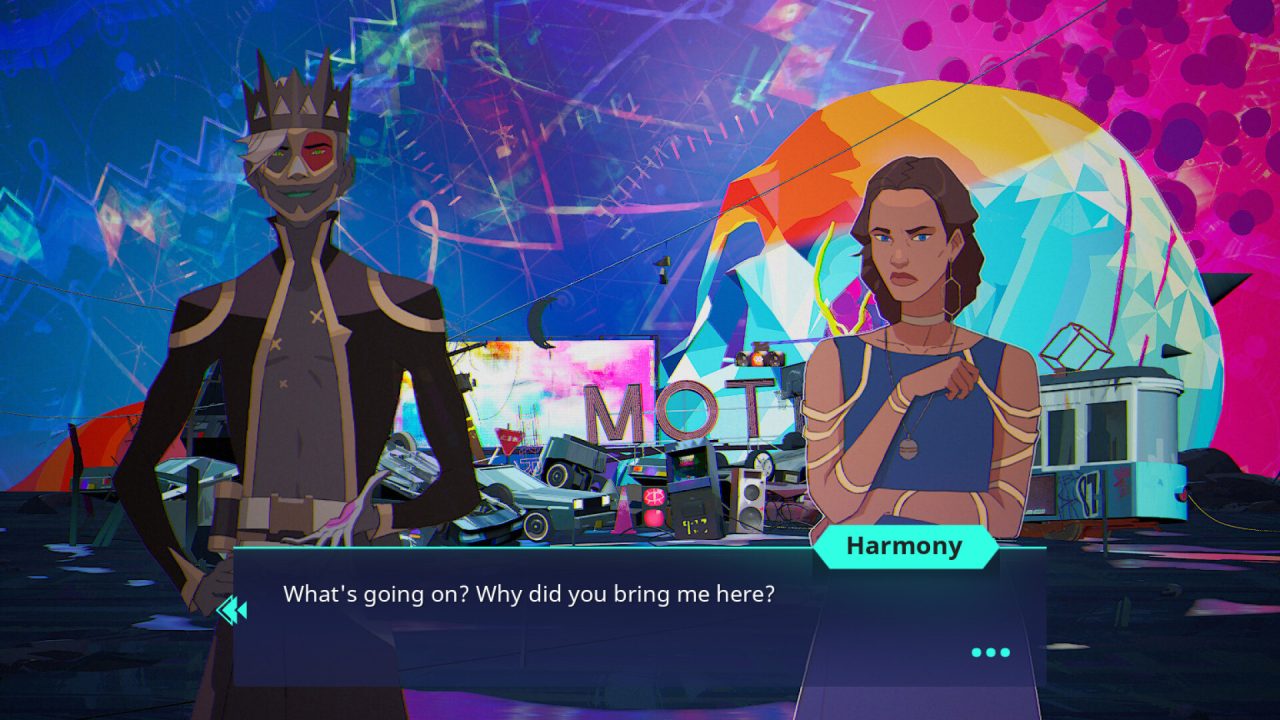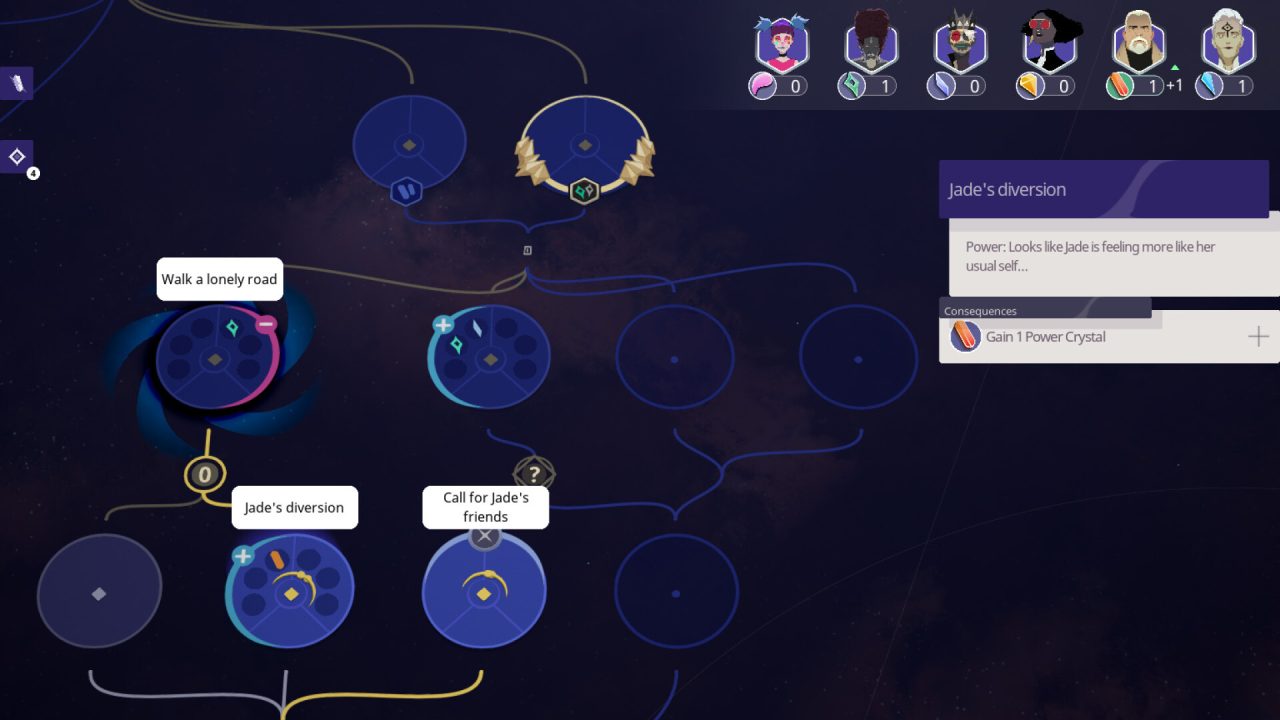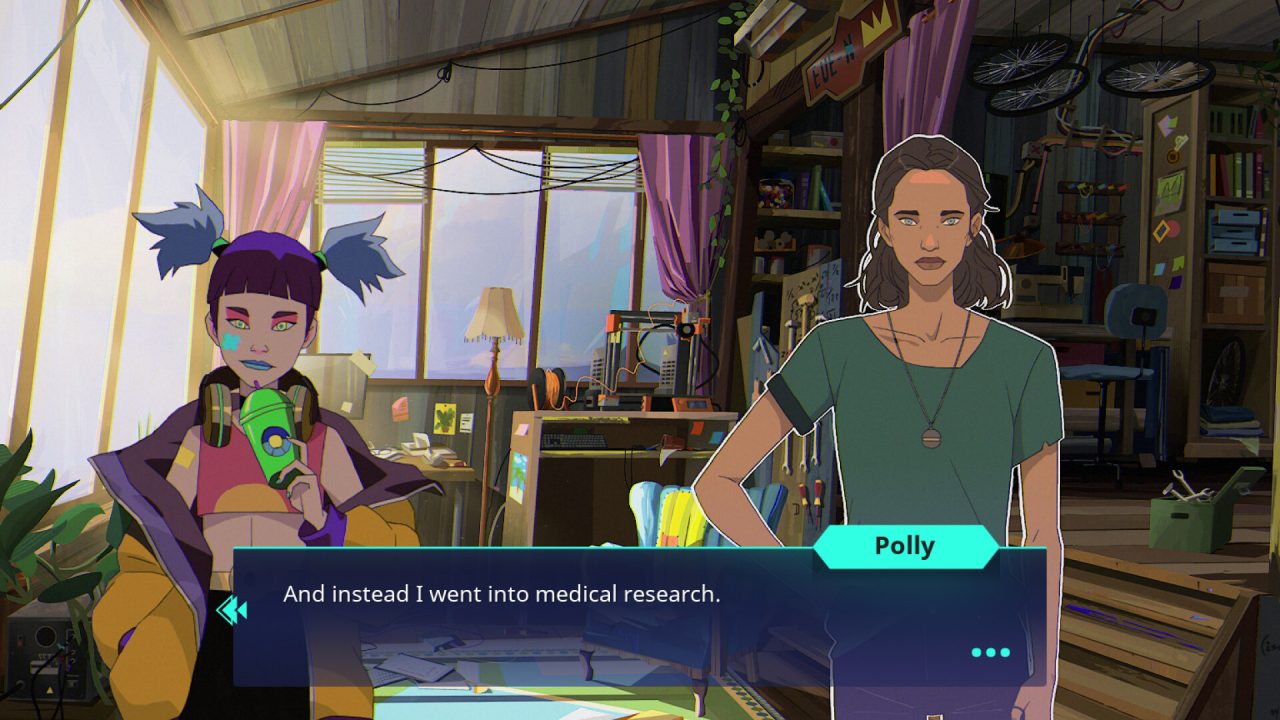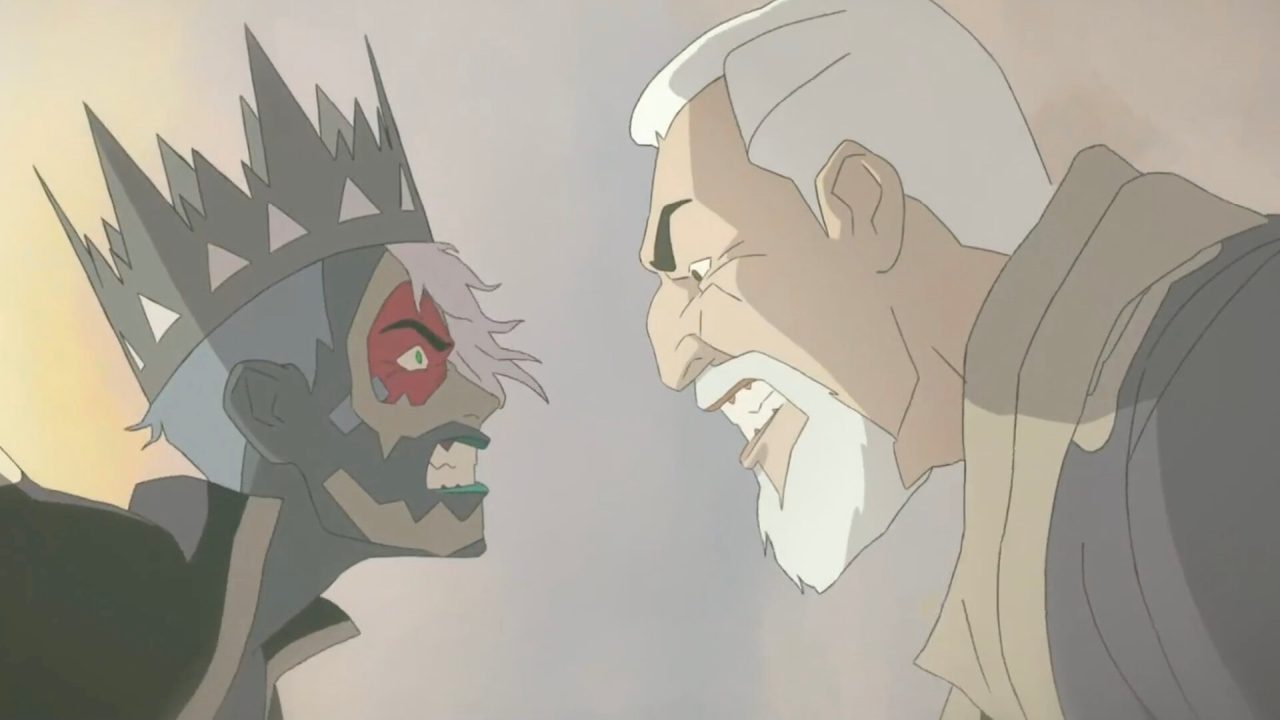Returning home after a lengthy absence is complicated, especially if it involves a family member’s disappearance. As the main character Polly soon discovers in DON’T NOD’s visual novel Harmony: The Fall of Reverie, it’s even more jarring when family secrets lean towards the supernatural. It isn’t long after Polly’s return to the fictional Mediterranean island of Atina in search of her missing mother that she finds herself at the center of two very different-yet-interconnected worlds, and how she approaches distressing situations in both creates lasting impacts on the fabric of reality.
As you no doubt surmised, Harmony: The Fall of Reverie takes place in dual worlds. The realm of Reverie is the home of godlike beings called Aspirations. The Aspirations are born from and represent different concepts of humanity, such as the factual Truth or the irreverent Chaos. Brittle is what the Aspirations call the human realm, represented by Polly’s estranged island home of Atina. Atina’s experiencing big changes, and it’s a place of significant importance to the Aspirations since that’s where they acquire an Oracle, the human link between their world and ours. Naturally, Polly is elected the current Oracle upon her return to Atina. She’s granted the power to see a slight degree into the future, shaping potential outcomes based on her decisions. But what do Reverie and the Aspirations’ goals have to do with her missing mother, Ursula? And how is Atina’s mega-corporation MK connected? Can Polly figure out the truth and help keep her family and the community safe? These are the questions Harmony: The Fall of Reverie answers with varying degrees of success.

It’s a good thing the story in Harmony: The Fall of Reverie is so compelling because the game is a visual novel at its core; narrative is the reason for playing. Harmony plays in much the same way as most VNs, with players taking on the role of Polly (or Harmony, as she’s called in Reverie) in a given scene, scrolling through text and dialogue with a simple button press. It’s in how the game divvies up these scenes to grant player interactivity that Harmony: The Fall of Reverie differentiates itself from other games in the genre.
Early in the plot, Polly accesses a device called the Augural. This tool’s meant to help guide her along her decision-making path as the Oracle, though it appears as a board game of sorts or a story map. Each node on the Augural represents an uncoverable narrative scene, with subsequent branching nodes representing a decision Polly can make in response to events and the potential repercussions of that choice. You can see further along the timeline to understand how a particular decision occurs. However, some future story nodes are “blocked” from view until you meet particular specific prerequisites to view them. At first, traversing the Augural is relatively easy and linear to help you get accustomed to the mechanic. However, in the later story acts and chapters, the branching narratives you can uncover become genuinely complex.

While navigating the Augural is daunting, there’s the involvement of the Aspirations themselves to consider, which complicates matters. They often have opinions on what’s happening in Reverie and Brittle, exerting their influence on scenes through crystal gaining. Polly makes certain decisions that favor one Aspiration over another, allowing her to gain a crystal for that particular Aspiration. For instance, doing something that influences a character’s happiness awards you a Bliss crystal for the joyfully childlike Aspiration of the same name. Gaining Aspiration crystals is vital to unlocking specific story nodes on the Augural; sometimes, you lose Aspiration crystals similarly. Depending on the crystals in your inventory, you can get locked into or out of specific plot outcomes on the Augural.
Crystals represent how much influence an Aspiration has, which you can keep track of in a readily handy graph. Raising an Aspiration’s influence affects the longer-reaching story outcomes determined at the end of story acts. It also acts as a tally to determine which Aspiration might become the new “heart” of Reverie, more powerfully exerting their influence over reality at large. You can favor one Aspiration over another throughout the game or try to balance their influence. There’s a fundamental level of strategy with manipulating the Augural, especially if you’re looking to reach specific outcomes. In my first playthrough, I leaned heavily toward Bond and Truth. But, based on going with my gut feelings regarding later decisions, I eventually found myself on Glory’s path. I pondered how that came to be once it became apparent that was the route I was on, looking back on what I either chose to do or not do on the Augural. It adds replayability, especially with its large number of potential branching points and decisions.
Harmony is genuinely fascinating, especially when it concerns the plot and characters within it. The Aspirations are phenomenally fleshed-out characters with a true sense of duality. None are wholly good or evil, simply existing as they are while admitting their faults and strengths when asked: compassionate Bond leads to a mob mentality; Truth is both revealing and cold; Bliss wants happiness but is ignorant of much else; Power acts swiftly but rashly; Glory is striding towards progress but inherently selfish; Chaos represents unbridled freedom but at the expense of the safety that comes from order. I love their mannerisms and differing viewpoints on Polly’s situations, remaining steadfast to their concepts throughout the game.

In contrast, the human characters in Harmony tend to differentiate more depending on Polly’s decisions, but they’re often a believable and likable bunch too. I especially love the adopted family unit of grandfatherly Laszlo, thoughtful Nora, and Polly. Polly’s missing mother, Ursula, is admittedly a character I had a hard time warming up to due to the decisions she makes throughout the game, but at the same time, I can understand where she’s coming from. Omar is an interesting character with a lot of hidden depth and two very different sides to his personality. At the same time, Jade and Yana are also both compelling characters in their ways. I love the developing relationships between them and Nora and Polly, respectively. I give Harmony: The Fall of Reverie credit for having a diverse cast. Not only is it diverse from a cultural stance, but also in age. Harmony is also quite positive in terms of LGBT+ representation and romances. This VN is a game with universal appeal as far as its varied cast is concerned!
Visually, Harmony: The Fall of Reverie has an extraordinarily unique and creative aesthetic. The best way to describe it is “animated.” The VN story scenes are far from static, as every character model is expressive and constantly moving across the screen. That kinetic movement isn’t something I usually associate with VNs, so it certainly helps Harmony stand apart from other titles in the genre. The animated cinemas are also nicely done, reinforcing the “moving” quality of the visuals. The vibrant coloring of most backgrounds also contributes to its visual identity. Things like a moving streetcar or flying drones in the background create a lived-in, moving scenery that isn’t the norm for most VNs. I also love the character designs, especially how exceptionally detailed they are! Sound-wise, Harmony: The Fall of Reverie relies heavily on voice acting to convey its story and character emotions. In that regard, the soundscape is fantastic! The voice acting for Harmony is incredibly dynamic and well-performed. I like the background music, too. However, the soundtrack is limited, and many scenes rely more on the voice work.

That last note leads me to Harmony: The Fall of Reverie’s biggest weakness: the sense that there’s an “incompleteness” to it. Certain scenes, particularly towards the end of the game, seem rushed or are incredibly brief. Polly and the other characters seem quick to adjust to the concept of Reverie without needing processing time, which makes sense for moving the story along quickly but requires a pause of belief on the player’s part. I like how unique it is to have a faceless antagonist like MK and how bleak facing something like that is realistically conveyed. Still, there is only a brief explanation of the characters’ despair leading to less emotional weight in certain scenes. Human characters, in particular, change their reactions based more on decisions within a contained chapter. For example, Omar gets upset in one chapter after Polly ignores his advice, yet is more supportive in the next one. Depending on how you approach a significant decision mid-game, Laszlo’s actions afterward remain unexplained at a certain point. There are too many decisions, and that leads to the story not constantly feeling cohesive. It’s a shame that this lack of cohesiveness permeates parts of the game, as Harmony’s plot is quite compelling overall.
Harmony: The Fall of Reverie is a text-heavy game with an impeccable English-language script. I love how poetically descriptive Polly’s innermost thoughts or actions are. I noticed that loading times were longer on the Switch port than when I previewed a demo on the PC. The slightly longer load times can occasionally break the game’s immersion, but they’re not drastic. The game saves automatically every time you access a story node, and you can restart a chapter from the beginning at any point if you haven’t completed it yet. Once you reach the end of a chapter, you’re stuck with the consequences of your earlier decisions. The chapter restart counts as a “hard restart,” so you can’t skip through previously viewed text. You’re stuck completing the beginning nodes to reach the branching points again. Since the game encourages replayability, it would’ve benefited exponentially from some auto-skip feature.
Harmony is a thought-provoking, emotional VN. The amount of artistic polish alone is impressive, and using the Augural to plot your branching decisions is intriguing, even if it isn’t without some flaws. Fans of the genre should give this one a chance, as I think DON’T NOD more or less reached their storytelling aspirations with Harmony: The Fall of Reverie. I’m already thinking of my next playthrough, which says a lot about how much I enjoyed my experience with Harmony!


